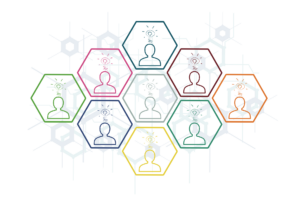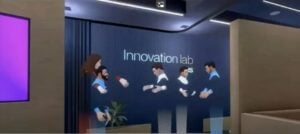Taking a Collaborative Approach to Intelligence
Collective intelligence tactics are being used in larger and complex research issues, from healthcare, government, technology, science and climate change to other pressing issues that society faces. One can discuss this collective intelligence approach through the lens of cultivating an innovation mindset, from the leadership and the team to the ways we train talent.
In a previous blog post on collective intelligence, we discussed how Atlan defined the group dynamics of collective intelligence, breaking it down into four concepts: human-based collective intelligence; computer-based collective intelligence; hybrid systems; and natural collective intelligence.
Here, we look at the more practical side of collaborative intelligence, and how it can play a role in corporate innovation systems. Harvard Business Review’s “How Collaborative Intelligence Can Boost Business Innovation,” looked at how, “Building a company culture in which everyone is connected to their teams and has a shared sense of purpose is fundamental for collaboration and innovation.”
Building a connected workforce can unlock insights, ideas and creativity. To make collaboration intentional and purposeful, organizations must develop, “collaboration spaces, both physical and online, where teams can connect. Second, there is collaboration design, the practice of introducing intentionality and technology to help teams connect and innovate. And finally, collaboration insights let organizations measure and improve their collaboration and innovation.”
Harvard Business Review outlines other principles of collaborative intelligence, which include:
- People are greater together than apart: Working in teams magnifies individuals’ power and value by coordinating a wider range of experience and expertise to tackle challenges and break down barriers to innovation and progress.
- Teams can’t exist without connection: Creating an environment that provides employees psychological safety, group commitment, and a common purpose forges a strong, productive employee culture.
- Collaboration should not be left to chance: Teamwork needs to be intentional. The acceleration of remote and hybrid work environments has eliminated the bygone passive strategy of depending on watercooler serendipity for innovation.
- Collaboration spaces power connected teams: A physical, digital, or hybrid common space encourages dynamic communication, getting past the limitations of email, documents, and chats for seamless collaboration in real time or across time zones.
- Measuring collaboration is possible and essential: Does working together really mean working better? The proof, as always, is in the data. Insight into how teams are collaborating helps organizations pinpoint how they solve problems most effectively, where their best ideas are coming from, and how they can come up with more.
More Resources on Collective Intelligence
All Things Innovation looked at this topic extensively in “Bringing Collective Intelligence to the Innovation Process.” Sometimes a problem is so complex that one person can’t solve it on their own. This calls for a more modern solution of cooperation and collaboration, and often to break down the silo mentality that can permeate a company. Open innovation can be one type of solution to this issue to provide resources and skills beyond the company’s four walls. Collective intelligence is another, broader and more community-oriented option, one in which a large group of individuals gather and share their knowledge, data and skills for the purpose of solving a specific problem.
Looking forward to FEI 2024? The conference, which will be held June 10 to 12, will feature the session, “Resilience Through Collective Intelligence,” presented by Chris Davies, Vice President, Audio, Sonos, Inc. The creative community is at the center of what Sonos does. The company’s commitment is to represent the artist’s intent. Following 100 years of technological evolution, Sonos continues to drive innovation to deliver on that commitment. Davies takes us through his current exploration into how far the organization can stretch computational power to gain artificial intelligence to add to their well-earned human intelligence. And ultimately attain organizational resilience through collective intelligence. Register for FEI 2024 here.
Discovering Resiliency Through Collective Intelligence
Resilience through collective intelligence offers several significant benefits, particularly in the context of innovation. We asked ChatGPT to outline some key benefits:
- Diverse Perspectives: Collective intelligence brings together individuals from diverse backgrounds, experiences, and expertise. By leveraging the collective wisdom of a diverse group of people, organizations can tap into a wide range of perspectives, ideas, and insights. This diversity fosters creativity and innovation by challenging conventional thinking and encouraging the exploration of new possibilities.
- Collaborative Problem-Solving: Collective intelligence enables collaborative problem-solving, where individuals work together to tackle complex challenges and find innovative solutions. By pooling their knowledge, skills, and resources, teams can overcome obstacles more effectively and generate novel ideas that may not have been possible through individual efforts alone. This collaborative approach fosters a sense of ownership and buy-in among team members, leading to greater engagement and commitment to the innovation process.
- Adaptability and Agility: Resilience through collective intelligence enables organizations to adapt quickly to changing circumstances and navigate uncertainty with agility. By drawing on the collective intelligence of diverse stakeholders, organizations can anticipate challenges, identify emerging opportunities, and pivot their strategies in response to evolving market dynamics. This adaptability is essential for staying competitive in today’s fast-paced and ever-changing business environment.
- Risk Mitigation: Collective intelligence helps organizations mitigate risks associated with innovation by spreading knowledge, expertise, and resources across a wider network. By engaging stakeholders from different departments, disciplines, and external partners, organizations can identify potential risks early in the innovation process and develop strategies to mitigate them effectively. This proactive approach to risk management reduces the likelihood of costly mistakes and increases the chances of successful innovation outcomes.
- Enhanced Decision-Making: Collective intelligence facilitates informed decision-making by providing access to a wealth of diverse perspectives and data-driven insights. By harnessing the collective intelligence of a group, organizations can make more informed decisions that are grounded in a deeper understanding of the problem space, market dynamics, and stakeholder needs. This data-driven approach increases the likelihood of making strategic decisions that drive innovation and create value for the organization.
Keeping Collective Intelligence in the Forefront
Overall, resilience through collective intelligence empowers organizations to harness the full potential of their people, processes, and resources to drive innovation and achieve sustainable growth. By fostering a culture of collaboration, diversity, and continuous learning, organizations can leverage collective intelligence as a strategic advantage to thrive in an increasingly complex and competitive business landscape.
The future looks bright for collective intelligence efforts, especially as companies attempt to steer away from the silo mentality that has so often stifled creativity in the past. As Harvard Business Review notes, “Collaborative intelligence can help your organization unlock the collective genius of individual employees and across teams and, in the process, fuse the full scope of their innovation and problem-solving capabilities so you can grow and lead.”
Video courtesy of Nesta, The UK’s Innovation Agency
Contributor
-

Matthew Kramer is the Digital Editor for All Things Insights & All Things Innovation. He has over 20 years of experience working in publishing and media companies, on a variety of business-to-business publications, websites and trade shows.
View all posts













































































































































































